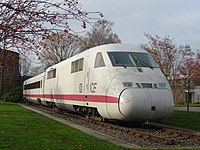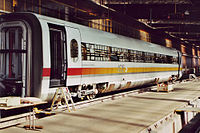Intercity Express
![]()
ICE is a redirect to this article. For other meanings, see ICE (disambiguation).
The Intercity Express (ICE) is the fastest train category of Deutsche Bahn. The Intercity Express is the flagship of Deutsche Bahn's long-distance passenger rail service and the successor to the Intercity (IC). It serves almost 180 ICE stations in Germany and five neighbouring countries (Austria, Switzerland, France, Belgium and the Netherlands) in a largely synchronised network.
Also referred to as "ICE" are the approximately 280 high-speed multiple units produced between 1990 and 2019 by various manufacturers. The multiple units are divided into five main variants - 60 ICE 1 (delivered from 1991 to 1993), 44 ICE 2 (delivered in 1996 and 1997), 91 ICE with tilting technology (including 71 electric multiple units (ICE T) delivered from 1999 to 2006 and 20 diesel-powered ICE (ICE TD) delivered in 2001), 84 ICE 3 (67 multiple units of the 403 and 406 series with delivery between 2000 and 2006 plus 17 of the 407 series (Velaro D) with delivery from 2014 to 2017) and about 50 multiple units of the latest generation ICE 4 (delivery status 2020), which started in 2017 and will only be completed between 2020 and 2025. Around 60 ICE multiple units operate abroad.
They reach top speeds of between 200 and 300 km/h in passenger service (320 km/h in France). In 2012, 76.6 million passengers travelled on the ICE. The average travel distance on the ICE was 335 kilometres in 2019. In 2019, the trains carried about 99 million passengers, which corresponds to a daily average of about 270,000 passengers. This corresponds to about 66 percent of the passengers in Deutsche Bahn's long-distance services. At 33.2 billion passenger-kilometres, trains accounted for 75 per cent of the transport performance.
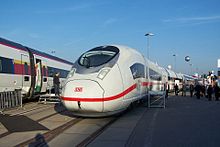
Class 407 (Velaro D) .
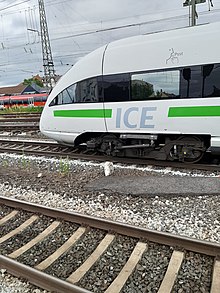
ICE logo with green instead of red trim on the rear cars.
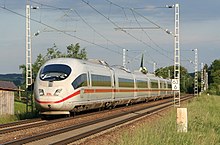
ICE 3 on the Munich-Treuchtlingen line
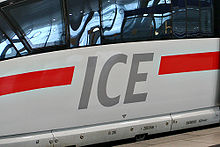
current ICE logo in DB Head font

Takts and maximum permissible speeds on the German ICE network (as of December 2017)

ICE logo
History
Development
Previous story
The basic research and development of track-guided high-speed transport (wheel/rail and maglev) was funded by the Federal Ministry of Research and Technology from the beginning of the 1970s until 1990 to the tune of 450 million Deutschmarks. Of this, about 70 million D-marks went to the development of the ICE.
The ICE precursor InterCityExperimental was presented to the public on November 26, 1985. On the same day, the train set a new world record for three-phase rail vehicles at 317 km/h between Gütersloh and Hamm. In the following years, the newly developed components were tested in their interaction at speeds never before achieved in Germany. The extensive results of the test program were ultimately to be used to develop demand-oriented vehicles for the high-speed service that was conceived from the 1990s onwards. In addition, the vehicle was used on numerous presentation runs to test passenger acceptance of future high-speed trains, including regular intercity passenger service. The vehicle was also used for numerous special journeys, including a trip by Mikhail Gorbachev on the new train during a state visit. As part of the ICE world record trip on May 1, 1988, the set, later called the ICE experimental train (ICE/V), set a new world speed record for wheel/rail vehicles at 406.9 km/h between Fulda and Würzburg.
In the early 1980s, locomotive-hauled trains (class 120) were planned to run at a maximum of 200 km/h over the new lines. In the course of lengthy discussions between Bundesbahn management and the Federal Ministry of Transport, the concept of the first ICE generation emerged. A key milestone in this process was the HGV project decided on in May 1984, which envisaged an accelerated start of high-speed traffic at 250 km/h. The project was based on the concept of the first ICE generation. After the equipment, car length and width as well as the number of trains had been determined, the first series vehicles (41 units) were ordered from 1987 onwards. On 13 January 1987, Transport Minister Werner Dollinger initially announced that the Federal Government had secured funding for ten ICE trains. Previously, it had been partially assumed that the cabinet was not prepared to finance the trains necessary for a sensible use of the high-speed lines designed for speeds of 250 km/h. The government was not prepared to finance the trains. According to plans at the time, a total of 40 to 50 ICE units were to be available when operations began on the lines in 1991. This was followed on August 1, 1987 by the formal approval of the Minister for the procurement of 41 series ICEs as well as the necessary maintenance facilities.
Award of contract
By letter of intent, the railroad ordered a total of 82 power cars in September 1987, and a total of 482 center cars in July 1988. In mid-July 1988, the Federal Ministry of Transport approved the procurement. The order was placed late. According to the railways, the first series should have been completely ordered by the end of 1987 in order to have 25 multiple units available by mid-1991 according to the original production schedule. In view of this late award of contract, the time schedule had to be tightened up.
The formal act of awarding the contract to the consortia by the Central Office of the Federal Railroad followed on January 20 (power cars) and February 20, 1989 (center cars). The purchase price of the first 41 multiple units ordered was about 1.8 billion D-Mark. A power car cost 8.7 million D-marks, a dining car four, a service car three, and the first and second class cars 2.7 million D-marks each (prices around 1990).
In the summer of 1990, the German Federal Railroad ordered 19 more sets worth about one billion D-marks. The first center cars (first class, second class, service cars) were delivered in late summer 1990, the first dining cars in the fall.
The first advertising measures for the ICE began as early as 1985, six years before the start of scheduled service. This took place within the framework of extensive marketing measures on the occasion of the 150th anniversary of the railway in Germany. From this year on, the railway advertised - also due to the planned ICE trains - in passenger and freight traffic for several years under the umbrella slogan "The new railway". The 1985 plan called for the new trains to be used initially on two lines, between Hamburg and Munich and between Hamburg and Basel via Frankfurt am Main, starting in 1991.
Name choice
The series train to be derived from the InterCityExperimental (ICE) was originally (according to the planning status of early 1985) to be called a high-speed train (HGZ). The designation InterCityExpress emerged from a lengthy discussion. The term was to be understood in both German and English. The E, for Experimental in the ICE precursor InterCityExperimental, was given the new meaning Express. A later renaming to InterCityEuropa was considered. In 1983, the IC successor project had also been called Intercity 2000. The abbreviation ICE had already been assigned on September 6, 1982, when the contract for the experimental train IntercityExperimental was awarded. As early as the mid-1970s, class 403 express railcars were running as Intercity Express between Munich and Bremen.
Market launch
Special features of the ICE
With the introduction of the ICE, the travel time between Hamburg and Frankfurt am Main, for example, fell by 62 minutes, and between Hamburg and Stuttgart - using both new lines - the travel time even fell by 115 minutes. In contrast, the train achieved no or only minor travel time advantages on the existing network. For example, the travel time on the Filstalbahn between Ulm and Stuttgart fell by only five minutes compared to the trains of the TEE and Intercity systems.
In addition to the high cruising speed (250 compared to 200 km/h), the comfort of the ICE was also significantly improved compared to the Intercity. For example, the cars were widened by 20 centimeters compared to the most modern IC cars at the time, making them the widest passenger cars ever in DB service. In addition, the seat spacing was increased by about 8 centimeters, and the number of seats in the second class cars was reduced from 88 to 66 with the same length. The seat spacing in second class (row seating) was 1025 millimeters. The backrests of the seats could be adjusted up to 40 degrees. The backrest was also infinitely adjustable, as were the seat and head cushions. Other comfort features included a particularly wide entrance, wide central aisles, automatically opening interior doors and exterior doors that opened at the touch of a button. Other comfort features included air conditioning with indirect ventilation, coat racks, lockers, telephone booths in first and second class, an eight-channel audio system in all seats, and video screens in some seats in both classes. A passenger information system based on on-screen text provided information about the train's speed, intermediate stops, and special offers, among other things. Service call buttons allowed first class passengers to call a conductor from their seat. Passengers could also be reached during the trip via the Euro signal of the European radio paging service and a train call answering machine.
For the first time, the ICE created pure smokers' and non-smokers' carriages on German rails, without the previously common separation within a carriage. The train formation was based on the InterCity trains: A dining car was inserted between the first and second class cars. Operationally, the ICE trains were treated as non-separable block trains. A fundamental innovation was the time-saving maintenance of the trains in the newly built ICE depot in Hamburg-Eidelstedt. This was done on three levels simultaneously, with technical faults being reported in advance by radio.
The ICE also brought a number of technical innovations to railway operations, such as the three-phase AC drive developed by Bombardier in Mannheim (from the class 120), electronic traction and brake control, and data transmission within the train via fiber optic cable.
Among the service innovations was the issue of vouchers to passengers when ICE trains were delayed by more than 30 minutes.
Commissioning
On 29 May 1991, ICE operations were inaugurated with a rally from Bonn, Hamburg, Mainz, Stuttgart and Munich to the new Kassel-Wilhelmshöhe station. After the trains had entered the station in parallel, Federal President Richard von Weizsäcker symbolically set the exit signal to "Drive" at 12:00 noon and said: "High-speed traffic in the Federal Republic of Germany is thus opened." He symbolically handed the key for the train to the driver of the scheduled premiere ICE. On June 2, 1991, the first regular ICE departed Hamburg-Altona for Munich at 5:53 a.m.; in the opposite direction, it departed Munich at 6:41 a.m.
The market launch of the ICE product, as the successor to the Intercity as the top product of the railway, took place under the slogan "Twice as fast as the car, half as fast as the plane". An advertising campaign accompanying the launch of the ICE highlighted, among other things, the speed, comfort and other special features of the new trains and emphasized the revolutionary character of the new top product. The print advertising showed, among other things, power cars, nose sections, middle cars (inside and outside), accompanied by texts such as: "156 years ago, train travel was considered exciting. Now it's that time again.", "250 peak. Relaxation as standard.", "A new sense of time, space and comfort." or - alluding to the train's modern-looking interior design - "June 2, 1991 marks the start of the railroad's space program." In addition, six commercials were shown on television. In 1991, the Bundesbahn spent around 18 million Deutschmarks on the advertising campaign surrounding the ICE - more than on any other campaign before.
The ICE was subject to surcharges from the beginning. The ICE surcharges were based on the gain in travel time compared to the IC trains. At the introduction of the ICE, the surcharge over the IC fares was between 3.40 and 24.00 D-marks in second class and between 4.00 and 40.00 D-marks in first class. Compared to the IC, fares rose by an average of 14 percent.
According to Deutsche Bahn, 2.5 million passengers used the trains in the first 100 days of operation, 25 per cent more than travelled on the routes in the previous year. One fifth of the passengers were new customers, and the average load factor was 54 percent (Intercity: 48 percent). The 26 ICE units achieved a punctuality rate of 82 percent.
With the introduction of the ICE between Dresden, Leipzig and Frankfurt am Main, the ICE network had grown to seven lines with a total length of around 5,000 kilometers by the end of May 2000. The busiest ICE hubs, Frankfurt am Main and Hanover, recorded up to six departing ICEs per hour.
Types / Versions
First generation
→ Main article: ICE 1
The first ICEs to run were the ICE-1 multiple units, which went into service in 1989. According to Deutsche Bahn, these ran from the biggest timetable change in Bundesbahn history on 2 June 1991 on the route from Hamburg-Altona via Hanover-Göttingen-Kassel-Wilhelmshöhe-Fulda-Frankfurt (Main)-Mannheim-Stuttgart-Augsburg to Munich as the new ICE Line 6. This meant that the first two high-speed routes opened in the same year (Hanover-Würzburg and Mannheim-Stuttgart) were integrated into the ICE network from the start. The trains of the first ICE line departed Munich for Hamburg at hourly intervals, between 5:41 and 16:41 (opposite direction analogously). The timetable change was also accompanied by new special and pass offers. By mid-1991, 270 drivers, 300 conductors and 60 on-board technicians had been trained for the new trains. The average cruising speed on the first line was 127 km/h.
In 1992, 29 multiple units were delivered, increasing the fleet to 43 multiple units. This allowed IC Line 4 (from Hamburg-Altona and Bremen via Hanover-Göttingen-Kassel-Wilhelmshöhe-Fulda-Würzburg-Nuremberg-Augsburg to Munich) to be completely converted to ICE multiple units as of May 31, 1992. Already since March 1st, nine Intercity rotations on this line had been replaced by newly delivered ICE units and were still running as normal Intercitys in terms of fares. With additional vehicles, the locomotive-hauled trains of IC line 3 could be supplemented starting with the summer timetable 1992. Starting with the timetable change on September 27, 1992, the ICE "Panda" was the first scheduled ICE train to travel abroad, from Hamburg via Frankfurt am Main and Basel to Zurich.
Again a year later, the ICE line 3 was newly established at the timetable change on 23 May 1993, now again hourly and from Hamburg-Altona via Hanover-Göttingen-Kassel-Wilhelmshöhe-Frankfurt (Main)-Mannheim to Karlsruhe, after the old Intercity line only ran every two hours and between Berlin and Karlsruhe from 2 June 1991. Already in the course of 1992, this had been condensed by individual trains from Hamburg-Altona to an almost hourly frequency, including three ICE train pairs. In this way, the ICE sets that were gradually delivered were promptly integrated into the interval timetable. At the end of 1993, 50 sets were available, with 21.9 million passengers and 23.9 million train-kilometres, the ICE accounted for 26.8 percent of long-distance traffic.
At the same timetable change, ICE trains ran to Berlin for the first time. Due to the lack of electrification and further construction work at Berlin Zoo station, the trains served Berlin-Lichtenberg station in the eastern part of the city, with an intermediate stop in Michendorf. A shuttle service with diesel trains was set up to the "Zoo". The ICE line 6 was moved from the Hamburg-Altona terminus to Berlin Zoologischer Garten station every two hours (via Magdeburg, then from 1998 via the Hanover-Berlin high-speed line), giving Berlin its first scheduled ICE stop. This eliminated the previously established shuttle service from the temporary Michendorf ICE station to the temporary Lichtenberg terminus. Individual trains of both lines 4 and 6 formed - deviating from the respective final stop in Hamburg-Altona and Berlin - from the 1992/1993 timetable onwards, a two-hourly service to and from Bremen Hbf, which thus also became a regular ICE stop for the first time, after there had been no through IC trains from Bremen to Göttingen and further since the network reform in mid-1985. From 25 September 1994, Dresden (via Berlin) was served by one ICE train pair daily, and since September 1995, several ICE train pairs have been running to Kiel.
On 23 May 1993, the ICE plant in Munich went into operation as the second ICE depot. Since 8 March 1994, the ICE has been running between Cologne and Berlin.
In 1993, all 60 sets of the first generation had been delivered, and 44 half-trains of the second generation were ordered. In the first three years of operation, 66.7 million passengers had used the ICE. In 1993, the 658 seats of the trains were used to an average of 47 percent of their capacity. In the same year, the ICE achieved revenues of DM 1.139 billion, an increase of 42 percent year-on-year.
In June 1993, an eight-car ICE multiple unit was shipped to the United States as part of the ICE Train North America Tour. The set, technically adapted for overseas use, made numerous presentation trips to 25 major cities in the United States and Canada and was used in scheduled service on the New York City-Washington, D.C., route (Northeast Corridor) at the end of 1993. (Northeast Corridor) in scheduled service. The train had been adapted for the power system of this route and was hauled by diesel locomotives on numerous other trips. Siemens and AEG-Westinghouse hoped to win an order for 26 trains through Amtrak. With the award to GEC-Alsthom in April 1994, Siemens' attempt to sell ICE train and track technology to Korea finally failed. Already at the end of May 1991, shortly before the start of scheduled ICE traffic in Germany, a consortium around Siemens was defeated by a competing group around Alstom in the award of a contract for a high-speed transport system in Texas. This and other attempts to sell the first ICE generation abroad were unsuccessful.
Starting in 1995, two ICE-1 trainsets were operated as so-called "idea trains" between Hamburg and Basel or Stuttgart. Among other things, cell phone amplifiers, the use of reusable bottles in the dining car, and concepts for Internet access on the train were tested on the trains. The trains later ran as regular ICE trains, without trials.
From May 1995, the ICE trains reached their maximum speed of 280 km/h for the first time on the ICE line 3.
The one hundred millionth ICE passenger was welcomed at the beginning of 1997. The average number of ICE passengers per day was 65,000.
The use of specially adapted ICE-1 multiple units as ICE-G for particularly fast freight traffic was examined in detail, but not realised.
| Performance data ICE traffic 1991 to 2000 (all ICE generations): | ||||||
| Year | million | billion | million | million | billion | Staffing level |
| 1991 | 5,90 | 2,04 | 6,0 | - — | 4,00 | 51 % |
| 1992 | 15,30 | 5,24 | 15,9 | - — | 10,40 | 50 % |
| 1993 | 16,40 | 7,70 | 24,4 | 26,3 | 15,10 | 51 % |
| 1994 | 20,80 | 8,15 | 28,1 | 29,3 | 17,40 | 47 % |
| 1995 | 24,60 | 8,74 | 29,3 | 30,8 | 18,00 | 49 % |
| 1996 | 25,90 | 8,85 | 31,1 | 32,3 | 18,80 | 47 % |
| 1997 | 28,30 | 9,78 | 34,1 | 35,5 | 21,56 | 45 % |
| 1998 | 31,40 | 10,15 | 38,5 | 40,0 | 22,25 | 46 % |
| 1999 | 35,64 | 11,59 | 44,6 | 46,2 | 26,26 | 44 % |
| 2000 | 41,61 | 13,92 | 50,0 | 51,8 | 27,99 | 48 % |
| (1) domestic only, including free riders | ||||||
Second generation
→ Main article: ICE 2
On 17 August 1993, Deutsche Bahn ordered 60 second-generation ICE trains at a cost of 2.2 billion deutschmarks; 44 were later delivered. Starting in October 1996, the ICE-2 multiple units went into service, which were intended to improve load management, among other things, through the concept of inter-couplable half-trains. Starting in December 1996, the first ICE-2 multiple units were used in regular service as scheduled.
Furthermore, starting with the 1997 summer schedule, these trains were used on the newly established ICE line 10 between Berlin and Cologne (in the daytime margins to Frankfurt am Main), and starting with the 1997/98 winter schedule, they were also used every two hours to Bonn. However, since the control cars had not yet been delivered or approved from the beginning, the railroad initially combined two half trains into a permanently coupled long train on this line. It was not until May 24, 1998 - after the acceptance of all control cars - that the wing train operation could be realized with the running of the ICE half trains from Hamm via Dortmund-Essen-Duisburg-Düsseldorf on the one hand or via Hagen-Wuppertal-Solingen on the other hand to Cologne or Bonn.
Then, in the fall of 1998, the third new line in Germany was opened with the new (Hanover-)Oebisfelde-Berlin line, shortening the travel time of the ICE Line 10 on the Berlin-Ruhr route by one hour. After the opening of the Cologne/Bonn airport station on 12 June 2004, the "Ruhr wing" was extended there. Since then, both wing trains met at the tower station Cologne-Deutz on different levels.
The ICE 1 and 2 trains are somewhat wider and heavier than the international railway association UIC prescribes for international trains.
In June 1997, the first ICE driving simulator went into operation in Fulda to train around 800 ICE locomotive drivers at the time. ICE simulators are now in operation at twelve locations.
An attempt by a consortium of Siemens, GEC-Alsthom and local companies to sell a combination of ICE and TGV technology as Eurotrain to Taiwan (Taiwan High Speed Rail project) failed unexpectedly at the end of December 1999. An ICE concept between the Brazilian cities of Rio de Janeiro and São Paulo was also not realized.
Third generation
→ Main article: ICE 3
In order to be able to use the ICE throughout Europe in the future, the vehicle gauge has been reduced on the new generation. An underfloor drive distributed over the train ensures lower axle loads for the cars in accordance with UIC specifications. Traction motors, transformers and other components were distributed along the length of the train, thus eliminating the need for power cars. Two test vehicles were put into service to test this distributed drive system: In the ICE D, a powered center car was added to a composition of ICE 1 cars and ICE 2 power cars. Further components were tested in the newly built ICE S, which today serves as a measuring and test vehicle for high-speed traffic.
The ICE 3 vehicle generation, ordered in 1994 and put into service from 1999, was developed in a domestic version (class 403) and a multi-system version ICE 3M (class 406) for the direct current networks in the Netherlands and Belgium. They are certified for 330 km/h and reach up to around 300 km/h in regular service. Like the ICE 2 trains, the new units were designed as half-trains and thus allow train journeys to be winged over different routes.
The multi-system ICE 3M has been running to Amsterdam (Netherlands) since 23 October 2000, and to Brussels (Belgium) since December 2002. The technical planning for a multi-system train designated as ICE-M had been funded by the Federal Ministry of Research since 1987. Since June 2007, ICE 3 MF trains upgraded for French traffic have been running between Frankfurt am Main and Paris (POS) at speeds of up to 320 km/h.
In 2000, supported by Expo traffic, the ICE's transport performance rose by 2.3 billion passenger-kilometres year-on-year to 13.9 billion. This year, the ICE was DB Fernverkehr's strongest train type, accounting for just under 40 percent of its transport performance.
Since the ICE 3 and ICE 3M are the only high-speed trains of Deutsche Bahn AG that can handle the maximum gradients of 40 ‰ on the new Cologne-Rhine/Main line opened in 2002, they are used on the lines that run over this route. The ICE 3s were first used as special "ExpoExpress" (EXE) trains for the Expo 2000 world exhibition.
The Nuremberg-Ingolstadt high-speed line was opened in May 2006 and fully integrated into the ICE network in December. Along with the new Cologne-Rhine/Main and Nuremberg-Erfurt-Halle/Leipzig lines, it is now the only high-speed line in Germany that permits speeds of up to 300 km/h. Between Nuremberg and Munich, an ICE half-hourly service has largely been established.
Tilting technology trains for upgraded lines ICE-T, ICE-TD
→ Main article: ICE T and DB series 605
At the same time as the ICE 3, the tilting technology trains ICE T (electric, in five- and seven-car variants) and two years later the ICE TD (diesel-electric, four-car) were developed in a similar design. They were specially designed for use on lines that have not been upgraded for high-speed traffic, for example on the winding lines in Baden-Württemberg, Bavaria, Hesse, or Thuringia. In doing so, the trains lean into the curves at an angle of up to 8° like a motorcyclist, which means that they can negotiate the curves up to 30 % faster (so-called curve-fast driving). The electric version is approved for 230 km/h. The trains were originally intended for IC traffic, but were later upgraded to ICE status due to their shorter travel times and high standard of equipment. Originally, the trains had bicycle compartments, which were replaced by additional seats in the course of the introduction into ICE traffic. Due to shortened inspection intervals caused by axle problems, the availability of the trains was limited from October 2008 to June 2009. Locomotive-hauled IC trains were used as replacements. Since then, the trains no longer run at curved speeds, and journey times have become significantly longer as a result. Plans to have the trains run at curved speed again by installing more robust axles have not yet been realised.
However, the diesel-powered ICE TDs, which were used on the Nuremberg-Dresden and Munich-Zurich lines starting in June 2001, initially proved to be prone to breakdowns and, according to Deutsche Bahn AG, too expensive to operate, so they were temporarily out of service. Since Easter 2006, however, they have been back in service as reinforcement and relief trains. Since 9 December 2007, they have also partially replaced the Danish MF between Hamburg and Aarhus and on the Vogelflug route between Hamburg and Copenhagen. In each case, a two-car train pair is run through from and to Berlin. For this purpose, the train will be divided at Hamburg Central Station for the two Danish destinations and reunited in the direction of Berlin. With this connection, there is a direct connection between Berlin and Copenhagen for the first time since autumn 1997, and at the same time two connections from Denmark directly into the German ICE network. This service is to be discontinued in December 2016.
Since the end of 2004, 28 seven-car trains of the second construction series (ICE T2) have supplemented the electric ICE tilting train fleet. Compared to the first series, among other things the video/audio program was removed and the footrests in second class were eliminated.
Fourth generation
→ Main article: ICE 4
On 9 May 2011, the contract between Deutsche Bahn and Siemens for the order of the new multiple units was signed.
Trial operation in passenger service began on 28 September 2016. Initially, ICE 581 (Hamburg-Altona-Munich) and ICE 786 (Munich-Hamburg-Altona) will run with the new ICE 4 multiple units.
Later, the most heavily frequented existing Intercity lines (including Line 30: Hamburg-Altona - Ruhrgebiet - Cologne - Koblenz - Mannheim - Stuttgart) are to be converted into ICE lines and ICE 4 multiple units are to be used. Furthermore, the multiple units are to replace the Intercity sets from the end of 2017[obsolete] on the lines on which no IC2s will be used.
Starting in February 2013, the first of 16 new class 407 multiple units (until 2015) were to supplement the ICE fleet. Among other things, they were to be used in cross-border traffic, on the Rhine-Rhone high-speed route from Frankfurt via Strasbourg to southern France, and from 2015[obsolete] from Frankfurt via Cologne to London. After multiple delays, the first trains have been in service since December 2013. By 2016, the rest of the fleet should follow[obsolete].
The trains are based on the Siemens Velaro, which is considered a further development of the ICE 3, and have already been sold - in similar variants - to Spain, China and Russia.
On 14 June 2013, Eurotunnel announced approval to run in the Channel Tunnel. Deutsche Bahn expected journeys from 2016 onwards. The plans are not being pursued further (as of 2016).
Various considerations to increase capacity by double-decker or extra-wide ICE multiple units (concepts ICE 21 and ICE 4) did not get beyond concept studies at the end of the 1990s.
By 2019, 177 ICE trains are to be equipped with the European Train Control System ETCS. The costs, including the re-registration of the retrofitted vehicles, amount to almost 90 million euros.
Future
In 2015, Deutsche Bahn announced its intention to expand the ICE fleet to 360 trains by 2030 and to offer 150 additional journeys per day. 150 journeys that today take place with IC trains are to be integrated into the ICE network. In 2030, about 120 million train kilometers should be provided. To this end, Deutsche Bahn had awarded a framework contract for up to 300 trains in May 2011, which were initially to replace the current IC trains from 2016. Between 2020 and 2026, 80 to 120 new ICE trains were to be put into service. Initially unveiled on 4 December 2015, the first 12-car ICE 4 trains were now to augment the existing fleet from December 2017, with 7-car trains replacing locomotive-hauled ICs from 2020. According to plans from 2016, for the foreseeable future all new ICE multiple units were to be called up exclusively from the ICE 4 framework agreement. From around 2022[obsolete], the ICE 1s were to be replaced by new vehicles, and from 2028, the ICE 2s as well.
In order to implement the Deutschland-Takt, vehicles with a speed of 300 km/h will be required above all in the future. In summer 2019, DB considered procuring a new generation of high-speed trains based on the ICE 3. In July 2020, Deutsche Bahn finally announced its intention to order 30 trains based on the 407 series with speeds of up to 320 km/h under the name "The new ICE", which will be delivered between 2022 and 2026. By 2026, a total of 421 trains are to be in service. The total volume of the order thus corresponds to around one billion euros. However, Deutsche Bahn is also keeping an option open for 30 more trains. The new trains are to be used primarily on the Cologne-Rhine/Main high-speed line and on the lines from Frankfurt (Main) via Nuremberg/Stuttgart to Munich. According to Deutsche Bahn, the final interior design of the trains will be presented in autumn.
In future tenders for new long-distance services, level access should be guaranteed.
Accidents
Only accidents of particular significance are reproduced below. Further accidents can be found in the articles of the individual ICE vehicle variants.
Eschede accident
→ Main article: Eschede railway accident
The Eschede rail accident on 3 June 1998 was one of the most serious rail accidents in the history of German railways and, in terms of casualties, the most devastating worldwide involving a high-speed train. 101 people were killed and 88 were seriously injured.
This was triggered by the breakage of a worn and defective wheel tyre. This wheel tyre drilled into one of the wagons and then pulled the check rail of a switch along with it. The force of the impact caused one of the wagon's wheels to overturn the switch tongue of a second switch. The following cars derailed and tore away the center pier of a 300-ton highway overpass, causing the bridge to collapse. All the following wagons hit the debris.
As one of the consequences of the accident, the railways have since dispensed with the use of wheel tyres on high-speed trains.
Derailment in the Landrückentunnel
→ Main article: Rail accident in the Landrückentunnel
On 26 April 2008, an ICE 1 on its way from Hamburg to Munich on the Hanover-Würzburg high-speed line ran into a flock of sheep at about 20:58 when entering the Landrückentunnel south of Fulda. Both power cars and ten of twelve cars derailed. The train came to a halt about 500 metres behind the tunnel entrance. Of the 148 passengers, 17 were injured. Damage to the train, track and tunnel amounted to around ten million euros. The section of track between Fulda and Burgsinn had to be closed for around two and a half weeks.
Broken axle in Cologne
→ Main article: Section "Problems of the wheelset shafts" in ICE 3
On 9 July 2008, an ICE 3 derailed while leaving Cologne Central Station, travelling at walking speed, in the switch area in front of the Hohenzollern Bridge. A wheel set in the front part of the train had broken, jumped off the rails and damaged the rails and points. Nobody was injured and all passengers were able to return to the platform. By order of the Federal Railway Authority, 61 of 67 ICE 3 multiple units were temporarily withdrawn from service on 11 July for further investigation. As a result of the accident, the Federal Railway Authority ordered a drastic shortening of the wheelset inspection intervals, which has since (as of February 2009) led to numerous train cancellations and further operational restrictions.
ICE train fires
According to Report Mainz, 39 fires involving ICE trains have been reported to the Federal Bureau of Railway Accident Investigation between 2008 and 2018, the most recent being an ICE-3 on the Cologne-Rhine/Main high-speed line near Dierdorf on 12 October 2018 (see List of railway accidents in Germany).
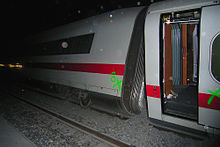
Derailed middle car of ICE 885 (multiple unit 111 "Nürnberg") in the Landrückentunnel south of Fulda (April 2008)

Accident site in Eschede - Remains of the ICE 884 "Wilhelm Conrad Röntgen

ICE 4 in Hanover

ICE TD: With four cars, the diesel multiple unit trains are the shortest ICE units (here in double traction).
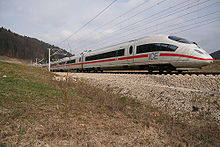
New design on the ICE 3: Long, rounded front end
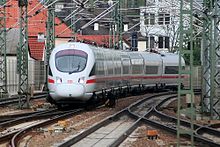
An ICE T tilts in a curve in front of the north station Ingolstadt

ICE S test train with a center car (2007) at the Geisberg Tunnel. The train was used with three center cars at the end of the 1990s to test powered center cars.

Eurotrain , a demonstration train temporarily composed of ICE-2 power cars and TGV Duplex center cars, in Munich in April 1998
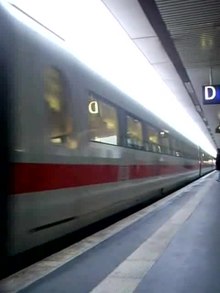
Play media file Video of an ICE 1 arriving in Hannover
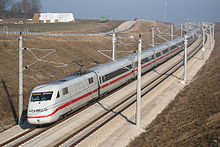
ICE 2 on the new Nuremberg-Ingolstadt line
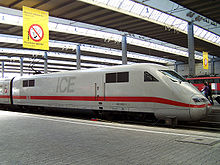
ICE-1 powercar 401 002 in Munich main station

ICE 1 on the new Nuremberg-Ingolstadt line
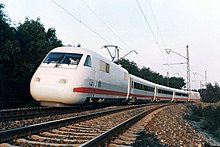
The ICE predecessor train InterCityExperimental. Here for the first time as a complete train underway near Munich (September 25, 1985).

The audio module integrated into the armrests was one of the new comfort features.
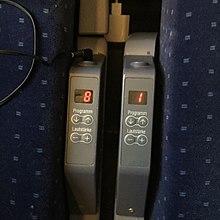
Further development of the audio module

Stamp of the German Federal Post Office for the opening of the high-speed traffic (1991)
Train material used
In the ICE system, around 280 high-speed multiple units of six different variants (ICE 1, ICE 2, ICE 3, ICE T, ICE TD, ICE 4) are in operation. In addition, the two sets of the former Metropolitan operate as ICEs between Berlin and Frankfurt or Düsseldorf (as of 2019).
Common ground
The ICE product is defined, among other things, by a uniform color scheme, similar interior design and various comfort features. The trains are maintained in special ICE plants.
Until the timetable change on 15 December 2002, many ICE trains listed in the timetable bore the names of important personalities, landscapes or sights. Since then, the ICE multiple units have been named after towns and cities. Since October 2002, more than 180 ICE multiple units have been named after German and individual European cities (as of March 2009). The train names of the ICE Sprinters have been retained. The first naming took place on 31 October 2002, when a multiple unit was given the name "Berlin". The new ICE 4 trains were again to bear names of important German personalities. The plans were scrapped in mid-2018.
Design
· 
Christened trains bear the name and coat of arms of the city on both ends of the end carriages or power cars.
· 
The old ICE colour concept with two-colour trim strip
· 
ICE DB logo on the end car of an ICE T
· 
Railway advertisement with the brand "ICE" on an airplane of the airline TUIfly
· 
Display of the speed inside an ICE (2017)
·
Display of the speed inside an ICE (2020)
·
The control unit for opening the doors
· 
Exterior design unveiled in 2019 with green trim and plug symbol on rear cars
A significant feature of the ICE is its color scheme, which was also protected as a design patent by Deutsche Bahn. The light gray paint scheme with traffic red stripes (RAL colors 7035 and 3020) and the continuous black window band, interrupted by oval door windows, distinguish them from all other DB trains.
On the first and second ICE generation, the trim stripe was initially, in accordance with the then current product colors of the German Federal Railroad, still orient red (RAL 3031) and set off by a second, thinner stripe in pastel violet (RAL 4009). This two-color scheme ended with the repainting of all ICE 1 and 2 during a "general inspection with paint refreshment" between 1998 and the opening of Expo 2000 in Hanover.
The ICE lettering is agate gray (RAL 7038), the aprons and the frame are quartz gray (RAL 7039). The plastic parts of the interior trim are all in the same light shade of grey (RAL 7035). Inside, indirect lighting and wood decor enhance the overall appearance. Originally, the interior of the ICE 1 was dominated by pastel shades such as mint green, according to the DB design common at the time. During the general overhaul of the ICE 1 trains between 2005 and 2008, the interiors were completely renewed and adapted in equipment and design to the third ICE generation.
For the 2006 World Cup, the World Cup logo was displayed on all ICE trains.
Starting in the spring of 2007, individual trains wore a new ICE logo in DB Type on a trial basis, which contained the DB lettering clearly visible. By the end of 2007, it was clear that the rest of the fleet would not be repainted.
In the 1980s, Alexander Neumeister and his team developed the familiar ICE exterior design with the ICE predecessor, the InterCityExperimental (ICE V), which was used on all ICE series. The interior of the first ICE series trains was designed by Jens Peters of the BPR-Design team in Stuttgart. The same team also developed the design of the Interregio trains in the mid-1980s.
On September 10, 2019, in Berlin, Germany's railways unveiled a revised exterior design that aims to better highlight sustainability by adding a green stripe to the end of the car that transitions into a green plug symbol.
External distinguishing features
| ICE (general) | Light gray paint scheme with red stripes and bellows transitions between the cars (in contrast to other DB trains), | |
| ICE 1 | Two power cars and middle cars; on-board restaurant / on-board bistro with high roof; nose flap with DB logo interrupting the red stripe, non-divisible long train with twelve passenger cars |
|
| ICE 2 | A powered end car, a center car, and a cab control car (with a passenger compartment). In contrast to the ICE 1: on-board restaurant/bistro has the same roof height as the rest of the carriages; the front flap can be divided vertically, the large spar protrudes, and there is a couplable half-train with seven passenger carriages. |
|
| ICE 3 | No power cars, but multiple unit: end car with round windshield and lounge (passenger compartment with view of the track), transformer car with pantograph (not powered); red stripe is interrupted at driving trailer by ICE lettering, runs down and over the nose flap; window band converges and ends at the height of the middle of the windshield, couplable half train with eight passenger cars | |
| ICE T | Like ICE 3, but: shorter "nose"; pantograph or aerodynamic covering of the brake resistors on end cars; window band and red stripe remain horizontal and parallel to the window band, window band converges to a point, red stripe ends in front of the lamps; upper point signal above windscreen; detachable, five- and seven-part | |
| ICE TD | Similar to ICE T, but only 4 cars & diesel instead of electric drive; since mid 2003 light emitting diodes as lower headlights; couplable |
|
| ICE T2 | Like ICE T series 1, but: no blind windows at the car crossovers, no glass parts between the side windows, painted sheet metal instead, three-light headlights with LEDs. | |
| ICE Velaro D ("new ICE 3") | Modified front section with horizontally opening front hatch and angular windows of the doors | |
| ICE 4 | Rounded angular front with angular instead of oval door windows |
|
| ICE V | Wide violet stripe runs lower and not over nose flap; logo of the Deutsche Bundesbahn and preliminary ICE logo; bellows covered on the outside; power cars higher than middle cars and rounder "nose"; nose flap since 1995 like ICE 2 |
|
| ICE S | "Old" pastel violet/orient red stripe runs on middle cars 1 and 3 in yellow/grey (railway colour yellow for railway service vehicles); ICE lettering in grey with addition "S" in white; grey dotted lines and yellow stripe form a curve diagram on car 2; power lines at car crossings; maximum speed indication (outside) 330 km/h instead of 280 km/h (note: composition of this train may change, characteristics of middle cars do not have to apply) |
|
| ICE D | Trial train for testing the ICE 3 - based on the power cars of the ICE 2 as well as middle cars of the ICE 1 and a powered middle car | |
Development of available space
When the ICE was introduced, in addition to achieving higher travel speeds, travel comfort was also increased compared to the Intercity by introducing larger seat spacing and wider aisles (for more details, see the section Special Features of the ICE). Accordingly, the ICE 1 offered an exceptional amount of space per regular seat; this space developed with the following ICE generations as follows:
| Comparison of available space per seat in different ICE generations | |||||
| Generation | ICE 1 (original) | ICE 1 (Redesign) | ICE 2 | ICE 3 | ICE 4 |
| Footprint standard trolley | 80 m² | 80 m² | 80 m² | 73 m² | 82 m² |
| Number of seats 1st class | 48 | 53 | 53 | 48 | 68 |
| Total space allowance | 1,67 m²/P | 1,51 m²/P | 1,51 m²/P | 1,52 m²/P | 1,20 m²/P |
| Percentage development of | 100 % | 91 % | 91 % | 91 % | 72 % |
| Number of seats 2nd class | 66 | 71 | 78 | 74 | 88 |
| Total space allowance | 1,21 m²/P | 1,13 m²/P | 1,03 m²/P | 0,99 m²/P | 0,93 m²/P |
| Percentage development of | 100 % | 93 % | 85 % | 82 % | 77 % |
Reading example: For a 2nd class passenger, a standard ICE 4 car provides about 77% of the space that was available to a 2nd class passenger in ICE 1 when it was introduced.
Carriage equipment
All trains are fully air-conditioned, have a dining car or bistro area, a passenger information system and a compartment for children. The backrests of most seats of the early generations are adjustable. In the ICE 4, the seating has been narrowed, so the backrest is no longer adjustable, but the depth of the seat cushion can still be adjusted. Power sockets are installed in all trains. In the 1st-3rd generation trains, footrests and headphone jacks were also available for listening to on-board music and voice programs as well as radio stations. In the ICE 3 and ICE T(D), panorama compartments at both ends of the train allow passengers to look over the driver's shoulder. Some seats in first class (originally also in second class) were equipped with video screens showing documentaries and films from Bahn TV. There are spaces for wheelchairs on all trains, as well as a barrier-free toilet with a changing table.
The carriages of the ICE are divided into three areas: Work areas, with mobile phone amplifiers for improved mobile phone reception, quiet zones, where mobile phone use and loud conversations are not desired, and areas not further designated. Mobile phone and quiet zones can be specifically reserved; the carriages are marked in the leaflet Your Travel Plan and by means of pictograms. The number of mobile phone-enhanced carriages should be increased to 1495 by 2011. This means that 70 percent of the seats in ICE cars should be equipped with mobile phone amplifiers.
The ICE 1 originally came with a BTX-based on-board information system, but its screens have since been pasted over. In the ICE 3, there were touch screens in some cars, which provide general timetable information on the entire rail network and can print it out if desired. The system can also be found in all ICE 2 trains in the on-board restaurant.
The modernization of the ICE 1 from 2005 to 2008 has now been largely completed. Seats and interior fittings were brought into line with the ICE 3 (including the installation of power sockets), the audio/video entertainment system and footrests in second class were removed. As with the ICE 2/3, an electronic seat reservation display was introduced.
See also: Redesign of the ICE 1
The ICE 2 trains provide a power socket at all tables. These are available in ICE 3/T trains and modernised ICE 1 trains (previously only in the conference compartment) at almost all seats.
All ICE 1 and ICE 2 are equipped with a dining car with restaurant and bistro area, as are the seven-car ICE T (class 411). In contrast, the ICE 3, the five-car ICE T and the ICE TD were designed without an on-board restaurant; instead, an on-board bistro with standing room and smoking and non-smoking areas was introduced. Since 1 October 2006 - in addition to the restaurants, which have always been smoke-free - the bistro areas on Deutsche Bahn trains have also been smoke-free. Since 1 September 2007, there has been a complete ban on smoking on all long-distance trains operated by Deutsche Bahn. This involved cleaning the upholstery and carpets in the trains' previous smoking carriages and completely replacing the seat cushions. A ban on smoking in the bistro had already been introduced on 1 August 1992. This was later abolished again.
Mobile telephony and Internet access
→ Main article: Section "Internet access in ICE trains (Railnet)" in Mobility Net and Intrain-Repeater.
As early as 1999, with the introduction of mobile phone repeaters, mobile Internet access via GSM/GPRS with low data transmission speeds was possible in ICE trains. Due to the constant expansion of GSM and the development of UMTS networks, fast Internet access is now possible during the journey, particularly in the conurbations. On the open road, it is generally possible to use the Internet at lower transmission speeds (GPRS) largely without interruption in carriages equipped with mobile phone amplifiers. Most ICE routes and tunnels have now been equipped for interference-free mobile phone reception.
Since the end of 2005, Internet access via WLAN has been possible in seven ICE 3 trains on the Dortmund-Essen-Cologne(-Siegburg/Bonn) route, followed by an extension to Frankfurt in spring 2007. By the end of 2007, the Frankfurt-Hanover-Hamburg and Frankfurt-Stuttgart-Munich routes were also equipped accordingly, and the number of WLAN trains increased to 38. At the beginning of 2015, the majority of the ICE fleet and the majority of the ICE network were equipped with mobile Internet access. Internet access is free of charge in first class.
In March 2015, Deutsche Bahn announced its intention to also offer free WLAN in second class from 2016, which has been the case across the board since 2017 except for wireless gaps in rural areas. From September 2015, free "in-flight infotainment" was to be provided, which was realised in the meantime through a cooperation with the provider Maxdome by using a free app with a limited offer. In the course of the discontinuation of Maxdome in summer 2020 by ProSiebenSat.1 Media, there will be a gradual switch to the new portal Joyn Selection, which will succeed Maxdome.
The Joyn Selection service will be discontinued on 1 July 2021. According to Deutsche Bahn, a new offer is being planned.
Lack of bicycle transport
The lack of possibility to take unpacked bicycles on ICE trains is often criticized - the conditions of carriage of Deutsche Bahn exclude the possibility to take bicycles on ICE trains. The ADFC, for example, regularly refers to the continuously worsening possibilities for taking bicycles on longer routes, as numerous Interregio and Intercity connections (with bicycle transport) have been replaced by ICE connections in recent years. According to the ADFC, the number of bicycles carried on German long-distance rail services has fallen from more than 500,000 to 250,000 per year since the mid-1990s (as of 2007) as a result of this reduction in services. In return, Deutsche Bahn AG points to high conversion costs for the ICE fleet (in the double-digit million euro range), longer stopping times at stations and the merely seasonal nature of bicycle transport, which would not justify the permanent elimination of a double-digit number of seats per train. The ICE trains called up from the future ICE 4 series (from around 2018[obsolete]) are to have a bicycle transport option.
In practice, however, fully packed bicycles (provided they do not exceed a certain size and can be carried by one person) as well as folding bicycles can also be transported on ICE trains; these are then considered to be a "load" and can be taken along free of charge - just like a normal piece of luggage. The only isolated bicycle transport options in German high-speed traffic are the TGV-POS trains that have been running between Stuttgart/Munich and Paris since June 2007, which can take four bicycles per train.
Only the majority of ICE-T and ICE-TD trains are prepared for the transport of up to 39 (ICE-T) or 10 (ICE-TD) bicycles. In practice, only five trains used in traffic with Switzerland between 1999 and 2002 were able to carry up to eight bicycles per multiple unit.
See also: section "Bicycle transport" in ICE T and section "Bicycle transport" in class 605
Maintenance concept
→ Main article: Maintenance of ICE trains
Maintenance is carried out in seven depots according to a concept that has been further developed compared to earlier vehicles in newly built depots or depots specially upgraded for the ICE in Basel, Berlin, Dortmund, Frankfurt am Main, Hamburg, Cologne, Munich and Leipzig. In the future, the trains will also be maintained at an SNCF plant in Paris. General inspections and the repair of accident damage are carried out at the Krefeld-Oppum and Nuremberg repair workshops.
One of the special features is that the trains are not usually separated during maintenance. Maintenance is carried out on at least three levels at the same time - underneath the vehicle, at boarding level and in the roof area. The regular work is usually carried out in seven stages from around 4000 to 1.65 million kilometres, depending on the mileage. The downtime for short workshop visits should be only one hour and mainly take place at night. Another significant innovation is the radio pre-reporting of defects stored in the computer-aided diagnosis system via remote data transmission while the vehicle is still on the road.

ICE 3 with T-Mobile hotspot sticker in Ingolstadt
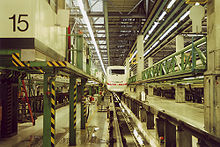
ICE plant Munich with ICE 1

Second class open-plan area in ICE 4
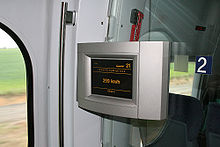
Passenger information system in the boarding area of the ICE 3
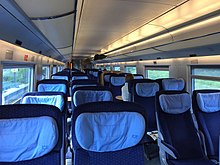
Second class open-plan area in the ICE T

First class open-plan area in the ICE 3
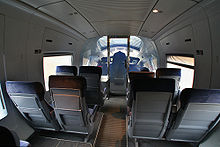
Second class lounge in ICE 3 with view of the driver's cab
Search within the encyclopedia
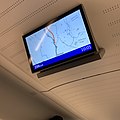

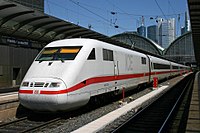
.jpg)
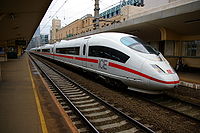
_(ICE_411_005-2_(Tz_1105)_Dresden)_23.5.2009.JPG)
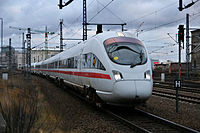
_(ICE_411_572-1_(Tz_1172)_Bamberg)_19.3.2009.JPG)
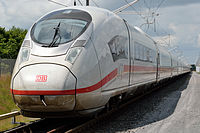
.jpg)
